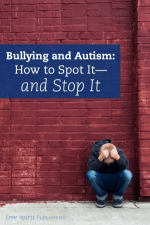1 in 3 students are bullied during the school year.
1 out of 4 are bullied every day.
Those with autism are especially at risk for being bullied.
 Bullying is when one student, or a group of students, purposely and repeatedly targets another student in a way that causes physical, social, or emotional harm. The ones doing the bullying usually have an advantage of some kind over those being bullied: size, strength, or popularity.
Bullying is when one student, or a group of students, purposely and repeatedly targets another student in a way that causes physical, social, or emotional harm. The ones doing the bullying usually have an advantage of some kind over those being bullied: size, strength, or popularity.
As moms, we’re angered and saddened by the bullying statistics we see. As moms of sons on the spectrum, we can’t help but worry—a lot. Kids with ASD (autism spectrum disorder) are often easy targets because they’re socially vulnerable and may have trouble advocating for themselves. As parents and educators, we all play a role in helping make our kids and communities more aware of the issues of bullying and autism.
Sean (names of students have been changed to protect their privacy) was targeted in middle school when a group of students stole all the stuff from his locker and hid it. Because of his ASD, Sean had difficulty understanding and communicating what happened. When his mom noticed Sean didn’t have his backpack, he only said, “I lost my stuff today.” But his mom knew there was more to the story—it wasn’t the first time her son had been targeted. She had to report the incident on Sean’s behalf and help locate the missing belongings. She also had to convince school staff members that Sean was being bullied.
Niko, another middle-schooler, had trouble on the bus, a place where bullying often occurs (other popular places for bullying are school bathrooms and playgrounds, where supervision isn’t as high). Niko liked sameness and routine, and he had a favorite bus seat. Some of the other kids noticed this and targeted Niko by purposely sitting in his preferred seat to provoke a reaction. Although one student in particular started the bullying, other kids soon followed suit. They took turns sitting in “Niko’s seat” each day on the way to school to upset him. The bus driver wasn’t aware of the situation, especially since multiple kids were playing this game of musical chairs. One day, the bus arrived at school, and a teacher who knew Niko well noticed how upset he looked. When she asked him what was wrong, the whole story came out. The teacher helped put a stop to the bullying and made sure to inform the bus driver so he knew what to watch for.
Maria was bullied in high school. Like Niko, she liked certain things to be the same, and this rigidity was reflected in her clothing and appearance. She dressed in all blue from head to toe, every single day. She had tactile sensitivities, so she wore a blue turtleneck and soft blue pants no matter the season. Her family bought her multiple sets of the same clothes so she had something clean to wear every day. It’s no surprise that Maria was an easy target. A group of popular girls constantly teased and mocked Maria about her appearance and found it hilarious when she wouldn’t change for gym. The verbal abuse finally grew so unbearable that Maria reported the students. The school responded appropriately, and Maria used the experience to share information about autism with other students, telling them about the challenges she faced. Nothing would have changed if Maria hadn’t found the courage to speak up. However, many students don’t.
As adults, we sometimes have to speak up for the kids who are the most vulnerable, while also teaching them the tools for self-advocacy. Keep your eyes and ears open, so you’re tuned in to bullying and ready to step in.
What you can do:
- Turn on your bully radar. Is an ASD student coming to class late, upset, injured, or not at all? Are any of his or her belongings missing or damaged, and do you suspect bullying? If you’re a parent of a child with autism, encourage conversations about how students treat each other at school, on the bus, and during extracurricular activities. Ask questions even if your child isn’t keen on conversation.
- Teach about bullying at home and in school. Discuss how bullying plays out physically, verbally, and socially. Suggest ways students can stand up for themselves and others.
- If you witness bullying, stop the incident immediately. Protect the student who has been bullied and give fair consequences to other students involved.
- Share stories about bullying from your own life or from famous people’s lives. Encourage students to read fiction books about bullying and talk about the stories in class or at home.
- Role-play incidents of bullying with students or with your child at home. Encourage kids to play different roles: the person bullying, the target, a bystander. Encourage empathy and self-advocacy. Kids who have ASD often need to practice repeatedly.
- When students report bullying, take quick, effective action. Know and follow the school’s procedures. If your school needs to do a better job of prevention and response, work with the staff to help make that happen.
Elizabeth Weiss Verdick has written children’s books for kids of all ages, from toddlers to teens. Elizabeth loves helping kids through her work as a writer, an editor, and a mentor to children and teens. She lives in Minnesota where she plays traffic cop for her many furry, four-footed friends.

Elizabeth Reeve is a child and adolescent psychiatrist who has worked with children and teens on the autism spectrum for 30 years. She has an adult son with ASD.
